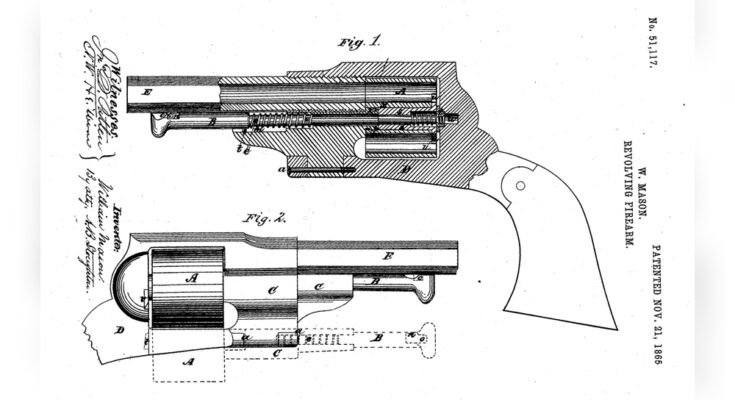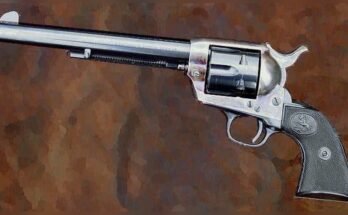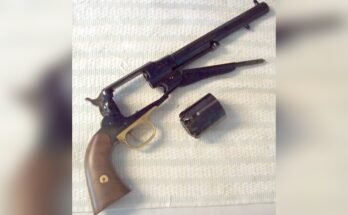Have you ever wondered what makes a swing-out cylinder revolver so unique and reliable? Whether you’re new to firearms or just curious about how this classic design functions, understanding the mechanics behind it can change the way you see revolvers forever.
You’ll discover the simple yet clever system that lets you quickly load, unload, and fire with confidence. By the end, you’ll not only know how it works but also why it remains a favorite among shooters worldwide. Keep reading—your deeper knowledge starts here.
Swing-out Cylinder Basics
The swing-out cylinder is a key feature in many modern revolvers. It allows easy loading and unloading of cartridges. This design improves speed and safety compared to older revolver types.
Understanding the basics of the swing-out cylinder helps you appreciate its function and benefits. The cylinder holds cartridges and rotates to align each round with the barrel. The swing-out mechanism lets the cylinder pivot out of the frame for quick access.
Cylinder Design And Function
The cylinder is a round, metal part with multiple chambers. Each chamber holds one cartridge. The cylinder rotates each time the revolver is fired. This aligns the next cartridge with the barrel and firing pin.
The number of chambers varies, but six is common. The cylinder locks in place when shooting to ensure safety and accuracy. It also must be strong to withstand pressure from firing.
Swing-out Mechanism Explained
The swing-out mechanism allows the cylinder to pivot out of the revolver frame. This pivot action is usually on the left side. A latch holds the cylinder locked during firing.
Pressing or pushing the latch releases the cylinder. The user can then swing the cylinder out to the side. This exposes all chambers for easy loading or removal of spent cartridges.
This design speeds up reloading compared to older fixed-cylinder revolvers. It also makes cleaning and maintenance easier. The swing-out cylinder is a simple but effective system used in many revolvers today.

Loading And Unloading Process
The loading and unloading process of a swing-out cylinder revolver is simple and safe. This design allows quick access to all chambers at once. The cylinder swings out to the side, making it easy to remove spent casings and insert new cartridges. Understanding this process helps users handle the revolver confidently and efficiently.
Ejecting Spent Casings
To eject spent casings, first unlock the cylinder. The cylinder swings out to the left side of the revolver. Press the ejector rod located under the barrel. This pushes all the empty casings out of the chambers simultaneously. Make sure all casings are fully removed before proceeding. This step clears the cylinder for fresh cartridges.
Inserting New Cartridges
After ejecting, load new cartridges one by one into each chamber. Hold the cylinder steady while inserting the cartridges. Ensure each cartridge fits snugly in its chamber. Swing the cylinder back into the revolver frame carefully. Lock it securely to prepare the revolver for firing. This process reloads the revolver quickly and safely.
Firing Sequence
The firing sequence of a swing-out cylinder revolver is a precise process. It ensures the bullet fires safely and accurately. This sequence begins with pulling the trigger and ends with the gun firing. Each step must happen in the right order for the revolver to work correctly.
Trigger And Hammer Interaction
Pulling the trigger sets the firing sequence in motion. It moves internal parts that control the hammer. The hammer is pushed back and then released. When released, the hammer strikes the firing pin. This impact ignites the cartridge primer. The primer then fires the bullet from the barrel.
Cylinder Rotation Timing
As the trigger is pulled, the cylinder starts to rotate. It moves to align the next chamber with the barrel. This rotation happens before the hammer falls. Proper timing is crucial to avoid misfires or jamming. The cylinder locks in place once the chamber is aligned. This lock keeps the revolver safe and ready to fire.
Advantages Over Fixed Cylinder Revolvers
Swing-out cylinder revolvers offer clear benefits over fixed cylinder models. Their design improves the shooting experience in key ways. These advantages make them popular among many firearm users.
Speed And Efficiency
The swing-out cylinder swings out to the side quickly. This allows for fast loading and unloading of cartridges. Reloading takes less time than with fixed cylinder revolvers. Users can reload multiple chambers at once with a speed loader. This quick action helps in situations that require fast follow-up shots.
Ease Of Maintenance
Swing-out cylinders make cleaning and upkeep easier. The cylinder can be removed or swung out for better access. This access helps clean each chamber thoroughly. Fixed cylinders limit access, making cleaning harder. Better maintenance keeps the revolver working reliably for longer.
Common Swing-out Cylinder Designs
The swing-out cylinder is a key feature in many revolvers. It allows quick loading and unloading of cartridges. Different models use this design in varied ways. Understanding these common designs helps to grasp how these guns work.
Two main types of swing-out cylinder revolvers exist. They are single-action and double-action models. Each type has unique features and mechanisms. Both types offer ease of use and reliability.
Single-action Models
Single-action swing-out cylinder revolvers require manual cocking. You must pull back the hammer before each shot. This action rotates the cylinder to align the next cartridge. The trigger then releases the hammer to fire the bullet.
These models have a simple and sturdy design. Many single-action revolvers have a visible hammer. This allows the shooter to see if the gun is cocked. They are popular for their precision and easy maintenance.
Double-action Models
Double-action swing-out cylinder revolvers work differently. Pulling the trigger both cocks and releases the hammer. This action rotates the cylinder and fires the gun in one motion. The trigger pull is heavier but faster for follow-up shots.
These models offer faster shooting without manual cocking. They still allow single-action mode by cocking the hammer manually. Double-action revolvers balance speed and control for many users.

Safety Features
Safety is a key part of how a swing-out cylinder revolver works. These guns have built-in features to prevent accidents. They help keep the user safe while handling and firing the revolver. Understanding these safety features shows how carefully these guns are designed.
Cylinder Locking Systems
The cylinder locking system holds the cylinder in place. It stops the cylinder from moving during firing. This locking keeps the chambers aligned with the barrel. Proper alignment is important for accuracy and safety. The lock prevents the cylinder from swinging open by mistake. It also blocks the cylinder from turning freely. This stops accidental firing and misfires.
Hammer And Trigger Safety
The hammer and trigger have safety parts inside. These parts stop the gun from firing unless the trigger is pulled fully. The hammer often has a block that stops it from hitting the firing pin accidentally. The trigger has a safety catch to avoid unplanned shots. Both features need the user’s full action to fire. These safeties reduce the chance of accidents greatly.
Historical Development
The swing-out cylinder revolver has a rich history shaped by many inventors. Its design evolved to improve speed and ease of use. Early models laid the groundwork for today’s reliable firearms. Each step in development focused on better handling and faster reloading.
Early Revolver Innovations
The first revolvers had fixed cylinders. Users had to load and unload each chamber separately. This process was slow and cumbersome. The idea of a swing-out cylinder came to solve this problem. It allowed the cylinder to pivot out for quick access. Early innovators experimented with different hinge mechanisms. These changes made reloading faster and safer. Colt and Smith & Wesson were key players in this phase. They introduced designs that set industry standards.
Modern Enhancements
Today’s swing-out cylinder revolvers use stronger materials. Stainless steel and alloys improve durability and reduce weight. Precision engineering enhances cylinder rotation and lock-up. Improved ejector rods make spent casing removal smoother. Ergonomic grips help shooters maintain control and accuracy. Safety features like transfer bars prevent accidental firing. These updates keep the classic design relevant and reliable. The blend of old and new technology defines modern revolvers.
Frequently Asked Questions
How Does A Swing-out Cylinder Revolver Operate?
A swing-out cylinder revolver works by pivoting the cylinder outward for easy loading. This design allows quick access to all chambers simultaneously.
What Advantages Does A Swing-out Cylinder Offer?
Swing-out cylinders enable faster reloading and better reliability. They also improve safety by allowing users to visually inspect chambers.
Can A Swing-out Cylinder Revolver Fire Multiple Calibers?
Most swing-out cylinder revolvers are designed for a single caliber. However, some models may support different calibers with specific cylinders.
How Do You Load A Swing-out Cylinder Revolver?
To load, swing the cylinder out, insert cartridges into chambers, then close the cylinder securely. This method speeds up reloading.
Conclusion
A swing-out cylinder revolver works by swinging its cylinder out for easy loading. This design makes reloading faster and safer. Each chamber holds one bullet, and the cylinder rotates with each trigger pull. The simple mechanism helps shooters fire accurately and quickly.
Understanding this helps appreciate old and new revolvers alike. It’s a clever way to handle ammunition efficiently. Knowing how it works adds to your firearm knowledge. Simple, reliable, and effective—that’s the swing-out cylinder revolver.



